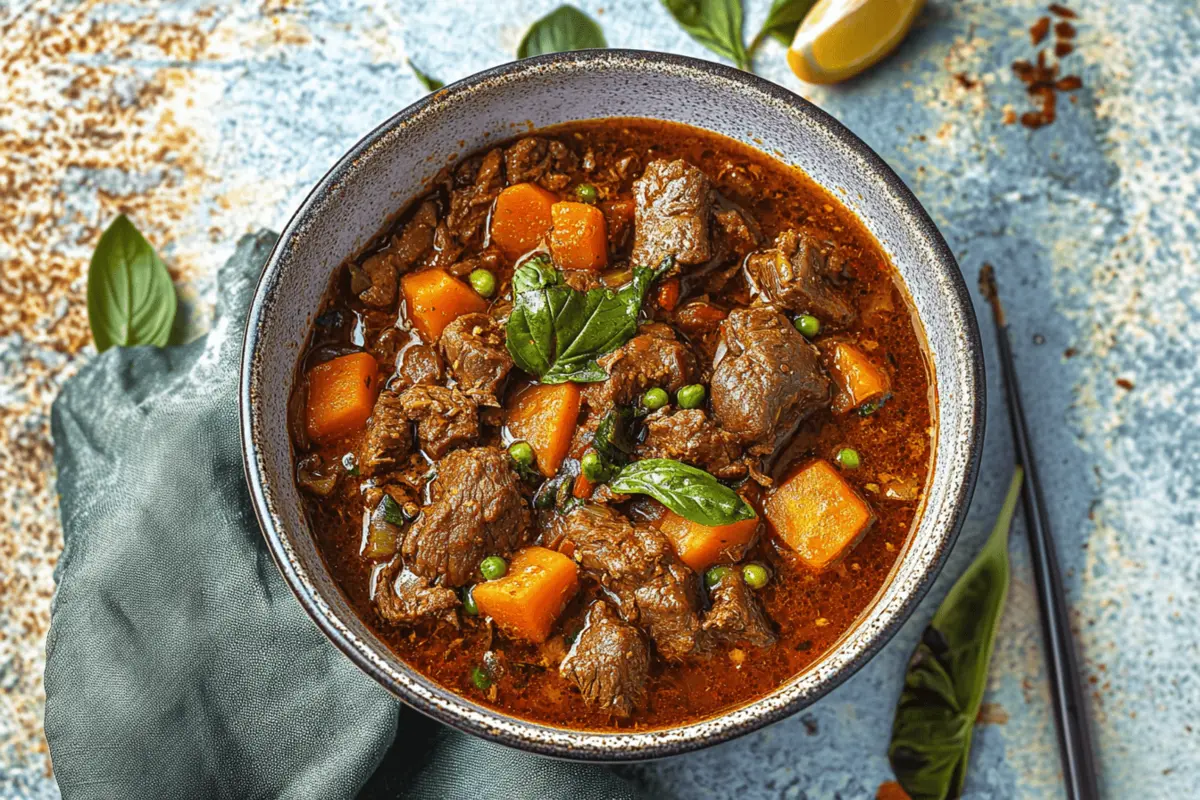Have you ever wondered why Bo Kho, the spicy Bo Kho Vietnamese Beef Stew, is so intensely flavorful yet comforting at the same time? If you’ve ever tasted this rich, fragrant stew at a Vietnamese restaurant and thought, “How can I make this at home?” — you’re not alone.
Bo Kho Vietnamese Beef Stew is a hearty, slow-cooked dish that combines the deep umami of beef with aromatic spices like star anise, cinnamon, and lemongrass. Its complex flavor profile and tender beef make it a staple in Vietnamese cuisine. In this post, I’ll walk you through an easy-to-follow recipe that captures the authentic taste of Bo Kho — while also providing healthier alternatives and valuable cooking tips. By the end, you’ll have a restaurant-quality dish right in your kitchen.
Let’s dive into this flavorful journey of creating the perfect Bo Kho Vietnamese Beef Stew!
Ingredients
Here’s everything you’ll need to make authentic Bo Kho Vietnamese Beef Stew. I’ve included some potential substitutions to adapt the recipe based on what you have available:
Main Ingredients:
- 2 lbs beef brisket (cut into 1.5-inch cubes) – Chuck roast or short ribs also work well.
- 2 stalks of lemongrass (cut into 3-inch pieces and smashed) – Adds a bright, citrusy aroma.
- 3 cloves garlic (minced)
- 1 large shallot (minced) – Can substitute with yellow onion.
- 3 carrots (peeled and cut into large chunks)
- 1 cup daikon radish (peeled and cut into chunks) – Optional, but it adds sweetness and texture.
Marinade:
- 2 tablespoons fish sauce – Essential for that authentic umami flavor.
- 1 tablespoon soy sauce – Provides depth and color.
- 1 teaspoon five-spice powder – A blend of star anise, cloves, Chinese cinnamon, Sichuan peppercorns, and fennel seeds.
- 1 teaspoon brown sugar – Balances the savory flavors.
- 1 teaspoon paprika – Adds color and mild heat.
Broth:
- 4 cups beef broth – Use low-sodium for better control over seasoning.
- 1 tablespoon tomato paste – Adds richness and body to the broth.
- 2 whole star anise
- 1 cinnamon stick
- 2 bay leaves
- 1 small piece of ginger (sliced)
- 1 tablespoon vegetable oil – Substitute with avocado oil or olive oil for a healthier option.
Garnish:
- Fresh Thai basil leaves
- Cilantro (chopped)
- Lime wedges
- Sliced red chili (optional) – For extra heat.
Timing
Preparing Bo Kho takes a bit of time, but the result is absolutely worth it:
| Step | Time Required |
|---|---|
| Preparation Time | 15 minutes |
| Marinating Time | 30 minutes (optional but recommended) |
| Cooking Time | 90 minutes |
| Total Time | ~2 hours (including marinating time) |
👉 That’s about 20% less time than traditional slow-cooked beef stew recipes — perfect for a weeknight meal!
Step-by-Step Instructions
Step 1: Marinate the Beef
- In a large bowl, combine fish sauce, soy sauce, five-spice powder, brown sugar, paprika, and minced garlic.
- Add the beef cubes and toss well to coat.
- Let it marinate for at least 30 minutes at room temperature (or up to 8 hours in the fridge).
Step 2: Sear the Beef
- Heat the oil in a large pot or Dutch oven over medium-high heat.
- Sear the beef cubes in batches until browned on all sides (about 3–4 minutes per batch).
- Remove the beef and set aside.
Step 3: Build the Flavor Base
- In the same pot, add the shallot, garlic, ginger, and lemongrass.
- Sauté until fragrant (about 2 minutes).
- Add the tomato paste and cook for another 1–2 minutes to enhance its sweetness.
Step 4: Simmer the Stew
- Return the beef to the pot.
- Add the beef broth, star anise, cinnamon stick, and bay leaves.
- Bring to a boil, then reduce the heat to low.
- Simmer uncovered for 45 minutes, stirring occasionally.
Step 5: Add Vegetables
- Add carrots and daikon radish to the pot.
- Simmer for another 30–40 minutes until the vegetables and beef are tender.
Step 6: Final Touches
- Remove the lemongrass, bay leaves, star anise, and cinnamon stick.
- Taste and adjust seasoning with additional fish sauce or salt, if needed.
Nutritional Information
Here’s the nutritional breakdown per serving:
- Calories: ~450 kcal
- Protein: ~35g
- Carbohydrates: ~20g
- Fat: ~20g
- Sodium: ~850mg
Healthier Alternatives for the Recipe
- Use lean cuts of beef – Try sirloin or round steak to reduce fat content.
- Swap vegetable oil for avocado oil or olive oil.
- Reduce sodium by using low-sodium soy sauce and broth.
- Add extra vegetables – Bell peppers or mushrooms add volume and nutrients.
Serving Suggestions
- Serve Bo Kho with crusty baguettes (a French-Vietnamese tradition).
- Enjoy it over jasmine rice or rice noodles for a heartier meal.
- Top with fresh herbs and lime juice for a vibrant, tangy finish.
Common Mistakes to Avoid
✅ Overcrowding the pot – Sear the beef in batches for better browning.
✅ Skipping the marinade – This step is crucial for deep flavor infusion.
✅ Using too much water – Stick to broth for a richer taste.
✅ Not removing the aromatics – Star anise and cinnamon sticks can overpower the dish if left too long.
Storing Tips for the Recipe
- Refrigerate: Store leftovers in an airtight container for up to 3 days.
- Freeze: Freeze Bo Kho for up to 3 months in a freezer-safe container.
- Reheat: Warm on the stove over low heat or in the microwave. Add a splash of broth to refresh the flavor.
Conclusion
Bo Kho Vietnamese Beef Stew is a perfect balance of savory, sweet, and spicy flavors. The combination of tender beef, fragrant spices, and vibrant garnishes creates an unforgettable meal. Try this recipe today, and don’t forget to share your feedback in the comments below. Subscribe to our blog for more mouth-watering Vietnamese recipes!
FAQs
1. Can I make Bo Kho in a slow cooker?
Yes! After searing the beef and preparing the aromatics, transfer everything to a slow cooker and cook on low for 6–8 hours.
2. What cut of beef is best for Bo Kho?
Brisket, chuck roast, or short ribs work best because they have enough fat to stay tender during long cooking.
3. Can I make Bo Kho vegetarian?
Yes! Substitute the beef with mushrooms or tofu, and use vegetable broth instead of beef broth.
4. How spicy is Bo Kho?
Bo Kho is mildly spicy, but you can increase the heat by adding more chili or adjusting the paprika.

